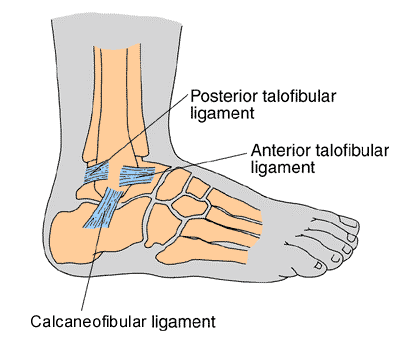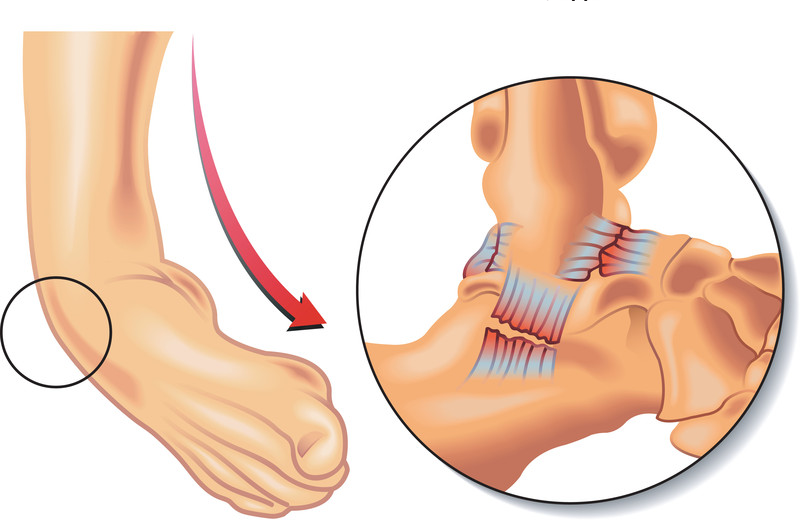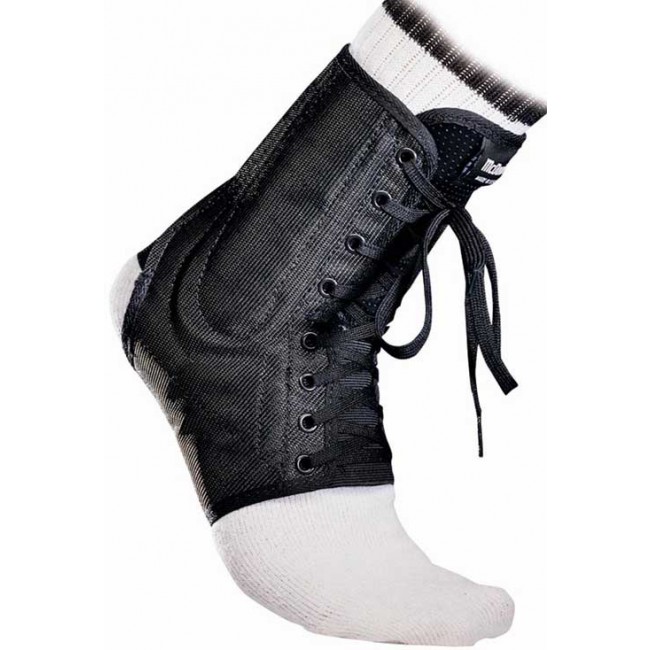Ankle sprain (ankle inversion trauma)
Complaint:
Complaints after an ankle sprain consist of pain, swelling, stiffness and a reduced load capacity of the ankle. The degree of the complaints depends on the severity of the injury. With a mild sprain, there is little pain. There is a slight swelling and you can still stand on the ankle. When there is a partial or total rupture of one or more ligaments, the pain is usually worse and there is considerable swelling with bruising. It is often almost impossible to put weight on the ankle.

Condition:
The ankle is strengthened by the joint capsule, tendons and ligaments that connect the fork of the ankle to the tarsal root and provide stability to the ankle joint. With an ankle sprain, the foot folds inwards while the leg is loaded. This can cause various injuries, usually affecting the outer ankle ligaments. The tearing of an ankle ligament is referred to as an ankle sprain. If the ankle ligament tears through, it is called a rupture.

Due to the pain and swelling, the distinction between a distortion or rupture can often not be made immediately. The ankle should therefore be re-examined one week after the trauma. If there is a suspicion of a fracture (broken bone), an X-ray may be taken.
Causes:
In the Netherlands, about 600,000 ankle sprains occur annually, of which 140,000 occur during sports. An ankle sprain is most common in young men (15-35 years old) and especially in football. Other risk sports are: handball, hockey, athletics, basketball, volleyball and (figure) skating.
Underlying factors can contribute to an ankle sprain. These can be properties related to the body (= intrinsic), but also environmental factors (= extrinsic).
Intrinsic:
Poor proprioception: the feedback of body position to the central nervous system resulting in impaired balance.
Ankle sprain in history
Extrinstic:
Intensive sports practice: especially explosive activities such as jumping, sprinting, twisting and turning.
Type of surface: e.g. The chance of ankle injuries in football players is higher when playing on artificial turf than when playing on grass.
Treatment:
For the treatment of an ankle sprain, it makes no difference whether there is a distortion (tear) or rupture (total tear) of the ankle ligaments.
It is important that immediately after the ankle sprain you cool the ankle with ice and apply compression by means of a compression bandage or tubigrip, and elevate the leg as much as possible. The ankle may be actively moved and loaded within the pain threshold for the first few days. From the second day onwards, the ankle should be protected with a brace.
An ankle sprain heals completely in most cases. However, for at least 3 months there is a greater chance of a new ankle sprain because the muscles are always slightly weaker due to inactivity and pain. It is also possible that the nerve endings that run through the ankle ligaments are damaged, so that the foot muscles are not controlled quickly enough, for example when correcting the foot on an uneven surface.
Exercise therapy:
The treatment of an ankle sprain is aimed at restoring the mobility of the ankle (see the instruction folder stretching exercises for the lower leg muscles), and to improve the coordination and stability of the muscles around the ankle (see the instruction folder stability exercises for the ankle and lower leg muscles). Attention should also be paid to maintaining the strength of the thigh muscles (see instruction folder Strengthening exercises for thigh muscles).
Training recovery:
You can start cycling on an exercise bike without load from 1 week after the injury). Depending on the severity of the injury, you can return to training recovery (with a brace!) after 2-4 weeks. Coordination exercises should be continued. When running, start by walking on a straight, flat surface and gradually increase the pace. If this goes well, you can start twisting and turning. If you play a ball sport, you can start exercising with a ball if you are walking well. Train with the ball for at least 1 week before you start training, and slowly build up the training before you start playing matches.
Medication:
Medications have no place in the treatment of ankle disorders. If necessary, paracetamol or ibuprofen can be taken for the pain.
Preventing an ankle sprain:
In 20 to 50% of cases, complaints of pain or instability persist after an ankle sprain. Preventing another ankle sprain is important to prevent further damage to the ligaments. Below are several measures that can be taken to prevent long-term complaints and recurrence of an ankle ligament injury:
Single tape
Ankle tape can help protect the ankle from a sprain. The advantage of tape is that it provides a lot of support and that the muscle reflexes occur faster due to the pressure on the ankle joint. The disadvantage is that the support decreases very quickly during exercise, after which tape offers virtually no firmness anymore.
Ankle brace
An ankle brace is very sturdy because it contains hard (plastic or metal) parts and provides good protection against a sprain. It is therefore recommended to wear a brace during sports for 3 to 6 months after the sprain. Disadvantages of a brace are that the firmness can hinder the mobility of the foot, and that a brace does not always fit easily in the sports shoe.

Om een volgende enkelverzwikking te voorkomen is het aan te bevelen om gedurende minimaal 3 tot 6 maanden na de verzwikking door te gaan met oefeningen gericht op het verbeteren van de stabiliteit en coördinatie van de enkel en onderbeenspieren. Eventueel kan een fysiotherapeut helpen bij het correct uitvoeren van de oefeningen en het genezingsproces begeleiden.
Wil je teruggebeld worden?
Door het invullen van het contactformulier ga je akkoord met onze privacy policy.
